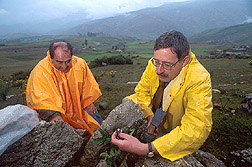This page has been archived and is being provided for reference purposes only. The page is no longer being updated, and therefore, links on the page may be invalid.
Unraveling the Mystery of Modern Potatoes' Origins
By Erin PeabodyMarch 18, 2005
When it comes to veggies, almost everyone can agree on potatoes. But despite its popularity, the common brown potato has a colorful history that some researchers are still disputing.
While potatoes are believed to have arrived in Europe in the 1500s from the South American Andes, Agricultural Research Service botanist David M. Spooner has uncovered DNA evidence showing that early potatoes also came from South America's southwestern coast, in lowland Chile.
From outward appearances, modern potatoes would seem to have Chilean ancestors. European potato plants have wide leaflets like Chilean ones, and both are "long-day adapted," which means they require the longer days of summer to form tubers.
But in the 1930s, researchers started challenging the notion of the Chilean connection, arguing that the first potatoes to reach Europe came only from the Andes. They claimed Chilean potatoes couldn't have survived the long journey from their native country, down through the Straits of Magellan and across the Atlantic.
According to Spooner, who works in the ARS Vegetable Crops Research Unit at Madison, Wis., potato seeds can last several years and so could have easily survived the trip. But even more compelling are data he recently assessed with colleagues at the International Potato Center in Lima, Peru, and the Central Potato Research Institute in Shimla, India.
The researchers surveyed an assortment of potatoes from India considered to be remnants of some of the first potatoes to Europe. They found that these descendants share specific molecular traits with potatoes from Chile--not the Andes.
Still, some argue that Chilean potatoes weren't introduced to Europe until after the famous 1840s Irish potato famine, to rescue the crop from the rot-causing late blight fungus. But, as Spooner points out, Chilean potatoes aren't known for having resistance to late blight.
With an increased understanding of modern potatoes' true ancestors, scientists can better preserve the world's potato plants to breed future varieties and realize the crop's natural disease- and insect-resistance potential.
ARS is the U.S. Department of Agriculture's chief scientific research agency.


